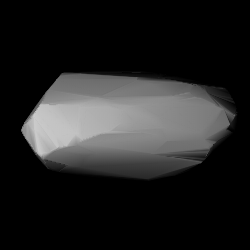Astronomy:161989 Cacus
From HandWiki
Short description: Near-Earth asteroid in 1941/2022
 Shape model of Cacus from its lightcurve | |
| Discovery[1][2] | |
|---|---|
| Discovered by | H.-E. Schuster |
| Discovery site | La Silla Obs. |
| Discovery date | 8 February 1978 |
| Designations | |
| (161989) Cacus | |
| Named after | Cacus (Roman mythology)[2] |
| 1978 CA | |
| Minor planet category | Apollo · NEO · PHA[1] |
| Orbital characteristics[1] | |
| Epoch 4 September 2017 (JD 2458000.5) | |
| Uncertainty parameter 0 | |
| Observation arc | 38.59 yr (14,096 days) |
| |{{{apsis}}}|helion}} | 1.3634 AU |
| |{{{apsis}}}|helion}} | 0.8828 AU |
| 1.1231 AU | |
| Eccentricity | 0.2140 |
| Orbital period | 1.19 yr (435 days) |
| Mean anomaly | 345.40° |
| Mean motion | 0° 49m 41.16s / day |
| Inclination | 26.060° |
| Longitude of ascending node | 161.24° |
| 102.16° | |
| Earth MOID | 0.0152 AU · 5.9 LD |
| Physical characteristics | |
| Mean diameter | 0.64±0.02 km[3] 1.126±0.073 km[4] 1.86 km[5] 1.9 km[6] |
| Rotation period | 3.7538±0.0019 h[6] 3.756 h[7] 3.761 h[5] 3.77±0.11 h[8] |
| Geometric albedo | 0.09[6] 0.119 (derived)[6] 0.199±0.052[4] 0.46±0.09[3] |
| Tholen = S[1][6] · Q[9] B–V = 0.910[1] U–B = 0.484[1] | |
| Absolute magnitude (H) | 16.58[6][7] · 17.1[4] · 17.2[1] · 17.32[5] · 17.43[3] |
161989 Cacus (prov. designation: 1978 CA) is a stony asteroid, classified as near-Earth object and a potentially hazardous asteroid of the Apollo group, approximately 1 kilometer in diameter. It was discovered on 8 February 1978, by German astronomer Hans-Emil Schuster at ESO's La Silla Observatory in northern Chile.[2] Its orbit is confined between Venus and Mars.
This minor planet was named from Roman mythology, after Cacus, a fire-breathing monster, which was killed by Hercules.[2] The official naming citation was published by the Minor Planet Center on 24 November 2007 (M.P.C. 61270).[10]
| Date | JPL SBDB nominal geocentric distance |
uncertainty region (3-sigma) |
|---|---|---|
| 1941-09-02 | 2418754 km | ± 6 km |
| 2022-09-01 | 8607710 km | ± 21 km[11] |
References
- ↑ 1.0 1.1 1.2 1.3 1.4 1.5 1.6 1.7 "JPL Small-Body Database Browser: 161989 Cacus (1978 CA)". Jet Propulsion Laboratory. https://ssd.jpl.nasa.gov/tools/sbdb_lookup.html#/?sstr=2161989&view=OPC. Retrieved 13 January 2018.
- ↑ 2.0 2.1 2.2 2.3 "161989 Cacus (1978 CA)". Minor Planet Center. https://www.minorplanetcenter.net/db_search/show_object?object_id=161989. Retrieved 13 January 2018.
- ↑ 3.0 3.1 3.2 Nugent, C. R.; Mainzer, A.; Bauer, J.; Cutri, R. M.; Kramer, E. A.; Grav, T. et al. (September 2016). "NEOWISE Reactivation Mission Year Two: Asteroid Diameters and Albedos". The Astronomical Journal 152 (3): 12. doi:10.3847/0004-6256/152/3/63. Bibcode: 2016AJ....152...63N.
- ↑ 4.0 4.1 4.2 Mainzer, A.; Grav, T.; Masiero, J.; Hand, E.; Bauer, J.; Tholen, D. et al. (November 2011). "NEOWISE Studies of Spectrophotometrically Classified Asteroids: Preliminary Results". The Astrophysical Journal 741 (2): 25. doi:10.1088/0004-637X/741/2/90. Bibcode: 2011ApJ...741...90M.
- ↑ 5.0 5.1 5.2 Degewij, J.; Lebofsky, L.; Lebofsky, M. (March 1978). "1978 CA and 1978 DA". IAU Circ. 3193 (3193): 1. Bibcode: 1978IAUC.3193....1D. http://www.cbat.eps.harvard.edu/iauc/03100/03193.html#Item1. Retrieved 13 January 2018.
- ↑ 6.0 6.1 6.2 6.3 6.4 6.5 "LCDB Data for (161989) Cacus". Asteroid Lightcurve Database (LCDB). http://www.minorplanet.info/PHP/generateOneAsteroidInfo.php?AstInfo=161989%7CCacus. Retrieved 13 January 2018.
- ↑ 7.0 7.1 Schuster, H. E.; Surdej, A.; Surdej, J. (September 1979). "Photoelectric observations of two unusual asteroids - 1978 CA and 1978 DA". Astronomy and Astrophysics Supplement Series 37: 483–486. Bibcode: 1979A&AS...37..483S.
- ↑ Koehn, Bruce W.; Bowell, Edward G.; Skiff, Brian A.; Sanborn, Jason J.; McLelland, Kyle P.; Pravec, Petr et al. (October 2014). "Lowell Observatory Near-Earth Asteroid Photometric Survey (NEAPS) - 2009 January through 2009 June". The Minor Planet Bulletin 41 (4): 286–300. ISSN 1052-8091. Bibcode: 2014MPBu...41..286K.
- ↑ Thomas, Cristina A.; Emery, Joshua P.; Trilling, David E.; Delbó, Marco; Hora, Joseph L.; Mueller, Michael (January 2014). "Physical characterization of Warm Spitzer-observed near-Earth objects". Icarus 228: 217–246. doi:10.1016/j.icarus.2013.10.004. Bibcode: 2014Icar..228..217T.
- ↑ "MPC/MPO/MPS Archive". Minor Planet Center. https://www.minorplanetcenter.net/iau/ECS/MPCArchive/MPCArchive_TBL.html. Retrieved 13 January 2018.
- ↑ "Horizons Batch for 2022-Sep-01 06:54 UT". JPL Horizons. https://ssd.jpl.nasa.gov/horizons_batch.cgi?batch=1&COMMAND=%27Cacus%27&START_TIME=%272022-Sep-01%2006:54%27&STOP_TIME=%272022-Sep-02%27&STEP_SIZE=%271+day%27&QUANTITIES=%2720,39%27. Retrieved 2022-01-17.
External links
- Lightcurve Database Query (LCDB), at www.minorplanet.info
- Dictionary of Minor Planet Names, Google books
- Asteroids and comets rotation curves, CdR – Geneva Observatory, Raoul Behrend
- 161989 Cacus at NeoDyS-2, Near Earth Objects—Dynamic Site
- Ephemeris · Obs prediction · Orbital info · MOID · Proper elements · Obs info · Close · Physical info · NEOCC
- 161989 Cacus at ESA–space situational awareness
- 161989 Cacus at the JPL Small-Body Database
 |

